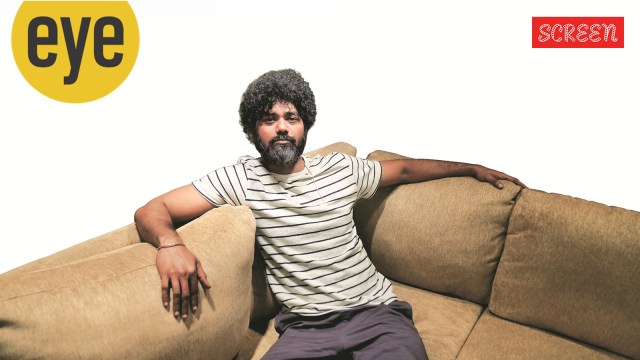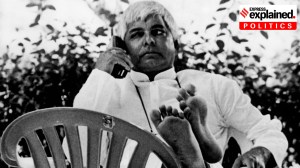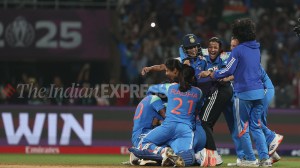Click here to follow Screen Digital on YouTube and stay updated with the latest from the world of cinema.
Sabar Bonda director on scripting a queer love story without the struggle that comes with it
Rohan Kanawade's debut feature film Sabar Bonda became the first-ever Indian fiction feature to win the Grand Jury Prize at Sundance Film Festival this year
 Film director Rohan Kanawade at Lalit Hotel in New Delhi on Thursday. Express photo by Abhinav Saha 11.9.2025
Film director Rohan Kanawade at Lalit Hotel in New Delhi on Thursday. Express photo by Abhinav Saha 11.9.2025The title Sabar Bonda encapsulates the journey of its characters and the passage of life. Thorny on the outside, and sweet and juicy on the inside, sabar bonda is the fruit that grows on cactus in arid regions. “Like the cactus that grows despite its harsh environment, protagonists Anand (Bhushaan Manoj ) and Balya (Suraaj Suman) have their hardships. And just as you peel the prickly skin to reach the juicy red fruit, their journey culminates in love,” says director Rohan Kanawade.
The 39-year-old filmmaker will always remember September 19 as the day his dreams came true — the day his first feature film Sabar Bonda (Cactus Pears) hit the theatres. The months and years leading up to the big day were dotted with stepping stones — screening at film festivals such as the San Francisco International Film Festival, Toronto International Film Festival and the BFI London Film Festival. Earlier this year, it became the first-ever Indian fiction feature to win the Grand Jury Prize at Sundance Film Festival.’
At the heart of the one hour-52-minute-long film is the intimacy — physical and emotional — between two men against the backdrop of funeral rites in a Maharashtra village. The tale traverses the realms of joy and grief, addressing hot-button issues like class and sexuality almost as innocuously as they creep into our lives. But none of it was on Kanawade’s mind when he set out to conjure the story, frame by frame. “I simply wanted to make a love story,” he says, “I never studied filmmaking. So I didn’t know the rules. For Sabar Bonda, once I had the premise, I let it take shape in my head — the vision, the visuals, the sound and performances; that took four years.”
 The poster for Rohit Kanawade’s directorial Sabar Bonda.
The poster for Rohit Kanawade’s directorial Sabar Bonda.
Kanawade’s fascination with cinema goes back to his childhood when his father, despite his meagre earnings as a driver, frequently took him to the theatres. “That’s how I got interested in the projector and surround sound,” he says. Magic happened when his penchant for stories and love for films came together in the last year of his school. While reading a chapter from his Marathi textbook, he began visualising the narrative in his head like a short film. “It was so cinematically written. That inspired me to explore writing and I started writing short stories,” says the director, who studied and worked in interior design before venturing into filmmaking.
Sabar Bonda is not autobiographical but it is much of Kanawade’s lived reality. He draws from the experience of attending the 10-day funeral rites of his father in his ancestral village. The opening funeral scene sets the tone for the film. When the city-bred Anand returns to his village for the rites, his marriage is discussed on loop by intrusive relatives who are unaware of his sexuality.
ALSO READ: The visual poetics of Sabar Bonda, caught between stillness and scrutiny, distance and closeness
“I had for years avoided going back to my village for the same reason. When I went for my father’s rites, the pressure was even more intense and I was constantly thinking about escape. That is when I thought: ‘What if I had a friend in this village who knew about my sexuality?’ And suddenly there was the idea for a film. As Anand and his childhood friend Balya spend time together, their friendship blossoms into love,” he says. The film also subtly brings to the fore the urban-rural divide. “Through the mourning ritual, I thought I could incorporate rural life. That also gave me a chance to root the story in our own soil because many people still feel that the sexuality issue is a Western idea,” says the director.
Unlike most queer films that use the trauma of societal nonacceptance — think Brokeback Mountain (2005), Moonlight (2016) and Boy Erased (2018) — as the basis of the narrative, Kanawade’s film shines in the lack of it. “Queer stories in the West often have tragic endings — if there’s no struggle, there’s no drama. I didn’t want to do that because I am inspired by the life around me. In Sabar Bonda, there is no struggle but there is still drama. That feels more human,” he says.
Much of Kanawade’s empathetic approach can be attributed to the support that he received throughout his life. His father and his partner, whom he met in 2014, were his greatest cheerleaders. That warmth finds a reflection in Sabar Bonda. Tenderness manifests in the physical exchanges between Anand and Balya, and in the silences they share. A scene where Balya casually runs his fingers through Anand’s hair is particularly evocative. “My father was a driver and my mother is untutored. But when I came out to them, they immediately accepted me. I did not have any kind of struggle. Rather it was positive and I wanted to use that,” says Kanawade.
In the film, Anand recalls his father’s reassuring words when he came out: “You know yourself and that’s important.”



- 01
- 02
- 03
- 04
- 05





























